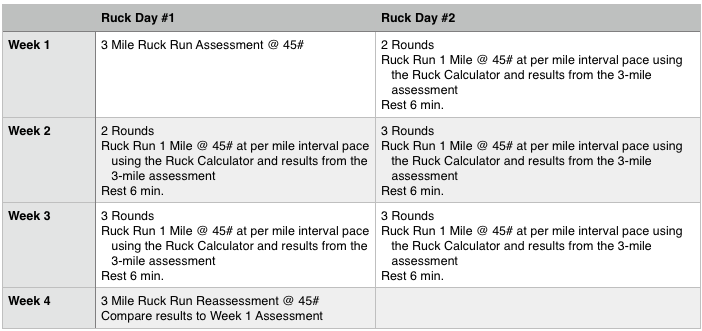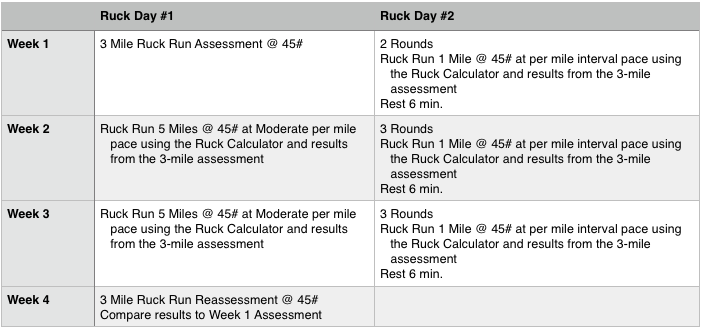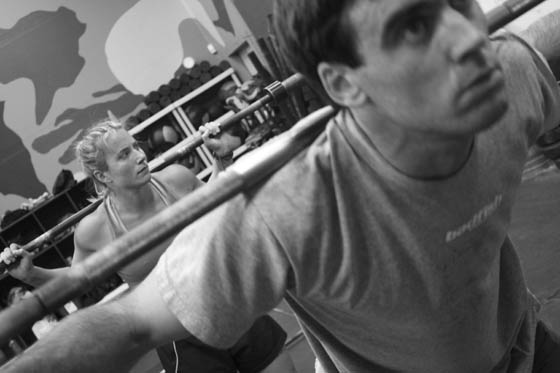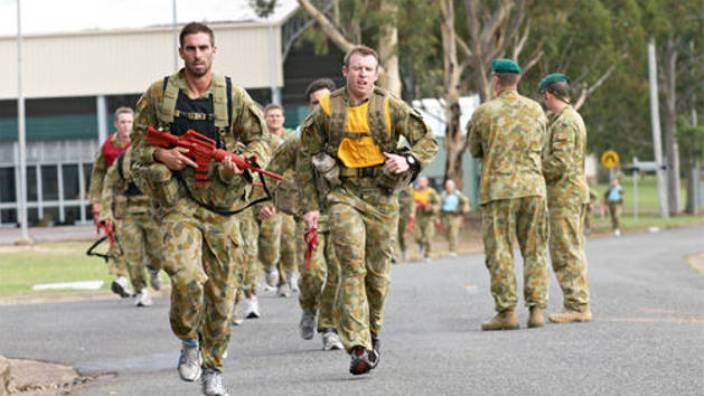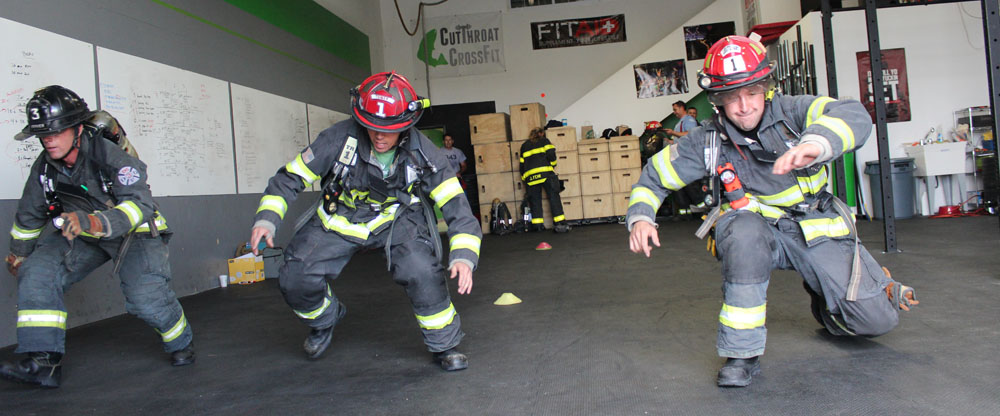KUDOS ON THE RUCK BASED SELECTION TRAINING PLAN
“Morning Rob, I hope you are well. Also I went to SFAS in May and got selected. I followed your Ruck Based Selection Plan and never had a problem – was told by the cadre I was a top 5 performer.It worked extremely well and I felt strong throughout. I know some guys have been saying there isn’t a need for the longer rucks (12+ mile), but I felt that they made the difference on the land nav phase, where just being on your feet under a ruck for days on end started to break down the other lads. Because I had the extra milage in the legs and back, I felt my ability to recover was much better. The only thing I did change was on some of the 2 mile intervals, I carried a 50lbs KB in one hand to work on grip strength and replicate events on Team week, that really gave me the edge. I watched people quit because of that.”
QUESTION
I’ve got a Rainier climb coming in 6 weeks. I’ve done it before but I’ve been getting out of shape due to injury. Injury should be good.
Is there a program that can help get me back my cardiovascular fitness and strength in time? I usually just do a heavy pack on a 8 mile round trip 3000ft mountain a couple times a week but my knees have been getting really sore.
ANSWER
We’ve built a sport-specific training plan for Rainer
HERE.
This is a 7-week plan – Complete weeks 1-5, skip 6, and finish 7 to coincide with your time left before the climb.
Good luck!
– Rob
QUESTION
I’ve been a huge fan of your training programs for the last five years or so while I was in the active duty serving with Marine Corps units in CA. I’m out of the Active Duty now, living in New York and just signed up for the Spartan Ultra Beast race in Killington, VT this September (four months out). The race is classified as 26+ miles of nasty mountain terrain trail running plus an assortment of functional-fitness based strength challenges along the way. I was wondering if you had a recommendation for which of your programs might be a good fit for training leading up to that race. I had in mind a schedule that would look something like:
Mon: Strength
Tue: Med Length Run
Wed: Strength
Thur: Hills/Stairs/Sprints
Fri: Strength
Sat: Long Run (Trail when possible)
Any thoughts on the matter would be greatly appreciated as this seems to fall a little in between the mountaineering programs (due to the fact that I will be running the vast majority of the race) and the Mil/LEO programs. Please advise and thanks again for all the great work you guys do. Cheers.
Very Respectfully,
ANSWER
Going in, you’re doing too much strength, not enough running. 4 months = 16 Weeks. From my stuff, here’s what I’d recommend:
Weeks Plan
1-6
Helen – Helen comes from our mountain base side and is a 6 day/week program, with two days in the gym training heavy strength, work capacity and chassis integrity. One change to this plan, skip Friday’s scheduled climbing gym work and run 2/3 the
distanced of Saturday’s prescribed trail run. So if the Saturday run is 9 miles, run 6 on Friday, then the 9 on Saturday.
7-16
Ultra Pre-Season Training Plan – this plan includes strength work – primarily bodyweight, but also cranks up your running and will prepare you for the 26 miles.
– Rob
QUESTION
Good evening, I recently subscribed to your athlete program and I have a question. I am currently switching over from the SOFLETE strength team just to change things up a bit. But as i look at your programs i see that a lot of them run 4-6 weeks. My question is, are you supposed to run the program, take a deload and then run it again, possibly even 3x? I assume that’s correct as i can’t see real progress being made in just 4-6 weeks. Any advice would be greatly appreciated, thank you.
ANSWER
Depending upon the athlete, 15-20% improvement is our goal for strength gains in one of our
strength-focused programs (
Rat 6,
Big 24,
Super Squats, etc.) over a 6 week cycle. The younger the training age of the athlete (how long they’ve been training), the greater the gain. The older the training age (longer they’ve been training), the lessor the gain. Older training age athletes should already have strength closer to their genetic potential – so have less room for improvement.
For younger training age athletes, we’ll see the bulk of the improvement in the first 3 weeks.
We don’t recommend repeating the plans again and again – first because of boredom/staleness, second for overtraining, and third, because one of the strength and conditioning truisms is “everything works, but nothing works forever.” Athletes accommodate to the training stimulus and new stuff is needed to spark growth.
If you’ve been focused on strength, I’d encourage you try on of our military programs which deploy Fluid Periodization and concurrently train strength, work capacity, endurance (running, ruck running, gym-based), chassis integrity and TAC SEPA (Tactical Speed, Explosive Power and Agility).
Our most recent iteration is found in our
Greek Hero series of plans. Start with
Hector, and follow the plans in the order recommended.
Regardless, good luck.
– Rob
QUESTION
Good morning,
Ran into your program through recommendation from a friend of mine. I have a quick question in regards to a few exercise programs.
I come from a high intensity/ high fitness background as an athlete. About 5 years ago I took a hard fall and had ACL surgery and it pretty much took me out of training and conditioning to the point that it became difficult to “jump back” in to it. I want to start at bodyweight foundation but I also saw the post rehab leg injury program as well. My legs have become pretty weak to my standards after the injury and never really pushing after rehab the knee so my question to you is after all these years, should I bounce into the post rehab leg injury program or just start at body weight foundation? Or rather blend the two?
Thanks for the help,
ANSWER
Email back on the other side.
– Rob
QUESTION
I have a few questions regarding the backcountry big game hunting plan. I am also going to be utilizing a mountain bike into my mountain hunting this season and would like to include this in my workouts. Do you have any recommendations to include that as well? My hunt is further out than 8 wks and I have no problem adding additional days to the workout plan to include biking. I do enjoy running as well and don’t want to replace that. Are there additional exercises included each week besides the ones listed in the sample week? Also, am I given full access to the plan if I purchase a subscription and not the plan or do I get access to new workout each day with the subscription? My hunting season starts in 15 wks and I have a long hunt in 17 or 18 weeks. Once the season starts I won’t be able to follow the plan as close and will have about 3-4 days a week for workouts.
1. Mountain Bike? Careful there. I sometimes use a bike to shorten my approach, but in terms of the actual time percentage I spend moving in the mountains, on-foot movement dominates and for me – it should be the bulk of my programming. If you’re going to be doing all your approaches on a bike, you could substitute mountain biking for the unloaded running in the plan. If you’ll use your bike from time to time to approach, you could alternate between unloaded running and biking. In terms of substitution, assume you’ll run 10 minute miles and make the sub for biking in time. For example, if the plan calls for a 4 mile run, bike for 40 minutes. Don’t substitute biking for step ups or rucking.
2. Additional exercises? This is sport specific training plan built focused on the fitness demands of backcountry big game hunting – mountain endurance, chassis integrity, uphill movement under load, eccentric leg strength for downhill movement, etc. The exercises I’ve chosen are the most efficient and transferable to mountains I’ve found so far, and no, there’s not a lot of exercise variety. Each week will be the same thing, only harder. This isn’t a general fitness training plan.
3. I’d recommend completing this plan the 8 weeks directly before your season starts – not your long hunt. The plan is full on, and training will interview with your hunting during week 16 (i.e. you’ll be sore and tired).
With the plan purchase you just get access to the 8-week Backcountry Big Game Training Plan. I wouldn’t recommend repeating it back to back, but it’s up to you. You could do some of your own programming then drop into the plan 8 weeks before your season.
With a subscription you get full access to the
Backcountry Big Game Hunting Plan as well as 190+ of our other plans. If you do this, I’d recommend doing
Humility for 7 weeks now, then dropping into the Big Game plan directly before your season.
– Rob
QUESTION
Started SF45 Alpha today with my climbing partner. Since January, we’ve been training general strength and conditioning in the gym, squats, deads, step ups, ect, We just climbed Mt. Washington this past week as our first test to assess our overall readiness for bigger objectives. While a relatively easy climb, Mt. Washington pointed out where our weaknesses are. Our big objective for the year is a climb of Grand Teton with Exum Guides in July.
Thought it was only day one, SF45 Alpha seems to be exactly what we needed to kick our training into a higher gear.
I feel, however, that since some of these exercises are unfamiliar, my form is not the greatest. I’ve watched the videos, but videos don’t tell you when you are doing something wrong. What do you recommend for me to learn better form for push presses, etc.?
Also, when we are in Jackson Hole, would it be possible to stop in to say hello, and possibly get some tips on exercises and future plans after we finish with Grand Teton?
Thanks for putting this plan together, I really feel my buddy and I will benefit greatly from it.
ANSWER
Exercise proficiency? Be smart with loading, get some practice, and there are literally a bazillion resources online. You could hire a coach if you’d like wherever you are, but most learn on their own.
You’ll want to do the
Peak Bagger Training Plan 6 weeks directly before your Grand trip. SF45 Alpha won’t prepare you sport-specifically for that event – and the Peak Bagger is specifically designed for one day, non-technical summits like the Grand.
Email when you’re in Wyoming – you’re welcome to visit the facility.
– Rob
QUESTION
Coach,
I’m looking to start your Army OCS plan. I’m not a great runner and I’ve never run 5 miles before. Workout #2 has the 5 mile run and I’ll be using the table you provide to find my 2-mile interval times. The thing is, I’m not going to be able to do the 5 miles in under 50 minutes and that’s the slowest time your table shows. The same goes for the 2-mile APFT pace table, it goes up to 17:29.. I’m closer to 20 minutes.
What would your recommendation be? Am I too unprepared to start this plan?
How far out are you from OCS? – Rob
FOLLOW UP QUESTION
Actually, I’m not going at all. My fiancee, on the other hand, is starting OCS in a few weeks. As silly as it sounds, I just want to endure a small fraction of what she’ll be doing there. I’m a police officer in the civilian world and need to get a jump on my fitness anyway, so I figured following the OCS plan would knock out both of those goals.
FOLLOW UP ANSWER
I’d recommend you begin with the
APFT Training Plan. This plan is assessment-based: you’ll take the APFT out of the gate, and use your assessment results for the follow-on progressions. The run is a more manageable 2-miles – and with this and the way the plan will automatically “scale” to your incoming fitness, it’s a good place to start.
– Rob
QUESTION
Hello Coach Rob,
I was pondering the following training programs you have:
“Greek Hero” Training Packet
Virtue Series
USAF CCT/PJ/CRO Training Packet
Fire/Rescue “Big Cat” Training Packet
My question is, if I were to partake in these programs would there be a crawl-walk-run type of order? I understand the Greek Hero training packet is for Green Tactical Athletes. I am actually trying to train and become what you call a Blue Tactical Athlete, but that series has not been posted yet. I would not want to start off too high of an incline and then become burned out part of the way through. I have been doing/coaching CrossFit for eight years and five years, respectively. I’ve also been training for Pararescue. I’m a power and strength background, so Olympic style weightlifting and power lifting are my bread and butter; endurance has become tolerable to keep it neutral. Just pondering your thoughts, brother, I’d like to get some quality training going. Any help will be much appreciated, thank you.
ANSWER
I’d recommend you begin our stuff with the
Virtue Series – specifically
Humility. It will get you out of the gym and away from barbells for a while, and start pushing your bodyweight strength endurance and military aerobic endurance (running/loaded running). Humility also has a distinct “hardening” effect, and my guess is you’ll appreciate the variety and being pushed in different areas.
– Rob
QUESTION
Hello, I just have a quick question. I’m starting a 30 week fire academy in just under 5 weeks. I’m planning on using your fire academy plan but wanted to ask your opinion. With the fire academy plan being a 7 week plan and my academy being 4-5 weeks out should I skip the first weeks or just do what I can of the plan before I start? Or is there another plan you would recommend.
ANSWER
Stick with the
Fire Academy Training Plan but don’t skip ahead. Follow it as prescribed until the last week before your academy, then skip to Week 7 in the plan.
Good luck! Excited for you!
– Rob
QUESTION
I have a surprise apft in 3 weeks. Would just pushing weeks 1-3 cause any appreciable improvement in performance, especially in the run?
ANSWER
You’ll definitely see improvement. How much depends upon how unfit you are now. If you’re unfit, you’ll see the most improvement. If you’re fit, you won’t see as much. Here is our
APFT Training Plan.
It deploys the APFT out of the gate, then uses your scores for the follow-on progressions. This way it automatically “scales” to your incoming fitness.
– Rob
QUESTION
I am trying to select the correct program to start with. A little background on myself. I’m currently 26 years old and plan to join the Ohio National Guard as an infantrymen. I have further aspirations but for now I need to focus on the 25 meter objective. I am a former college athlete (football) however I have hardly maintained a level of fitness acceptable for service. I’m 6’2″ 235#s and recently did an army style APFT test in which I completed 62 pushups, 41 sit-ups, and an 18:15 2 mile run. I have a long way to go to max the PT score which is my intentions. I also have a case of chronic tendonitis in my left knee, which I believe is the result of an ACL reconstruction I had while as a college athlete. The injury occurred before my final season and due to a lack of proper rehabilitation I have developed a substation strength imbalance between legs as my right leg is 2-3 inches larger. I’m looking for a program to establish a strong cardio base, improve sit-ups as I have struggled to improve these on my own, and bullet proof my lower body from tendonitis issues. I have trained on and off for the past 3 years and will be the first to admit that my knee improves greatly when it is strengthened, I just have no idea how to properly correct the imbalance. Sorry for the book but I’m sure the background will help in your recommendation. Also I was have full intentions on setting up an account and yearly subscription but am trying to understand the benefits as to opposed of just buy a plan.
Thanks you for you help and for your time,
ANSWER
Hi Ben –
I’d recommend you begin our stuff with the
APFT Training Plan and see how your knee/leg responds to the running, and sprinting in the plan. My guess is it will strengthen with training and start to even out.
Also – fix your diet. I’d like to see you around 215#. Here are our Nutritional Guidelines.
Plan purchase vs. Subscription?
A plan purchase gives you access to one training plan, and all it’s updates as we evolve our programming. It’s like buying a movie DVD.
An
Athlete’s Subscription gives you access to all 190+ of our training plans (military, law enforcement, fire/rescue, mountain, general fitness, legacy) and their updates, plus our daily programming for military, law enforcement and mountain athletes – but you lose access if you cancel your subscription. It’s like subscribing to Netflix.
– Rob
QUESTION
Coach,
I just returned from a NTC rotation at Fort Irwin this past weekend and I am looking at starting my train up for SFAS. I plan on doing your Ruck Based Selection Program 8 weeks before my selection date (which as of right now I do not know). I believe my selection date will be either end of this upcoming October or around January-February 2018.
I am thinking of doing running Mon/Wed/Fri and rucking Tues/Thurs/Sat for morning PT and then do training programs in the afternoon.
I wanted your advice on which training plans to use. I would say my weakest area is my endurance/run times physically, but coming back from NTC I know I have lost a little bit of strength as well. I have looked into the Ruck Based Selection Packet, but realize that I may not have enough time to complete the entire packet.
Which plans do you suggest I prioritize in my train up prior to using the Ruck Based Program?
Thank you for your help and programs. They have redefined the way I get after attaining my desired physical fitness levels.
ANSWER
You should train like SFAS is in October. Based on my calendar counting skills and best guess, if so you would be starting the
Ruck-Based Selection Training Plan the last week in August. That gives you 13 weeks to fill.
Glad our stuff has worked for you and good luck!
– Rob
QUESTION
Hey coach,
I wanted to ask for some back up on supporting ruck-running. I’m a 2LT in the Infantry and I’m currently on your Valor Training Program in the Ruck-Based Selection Packet. A lot of the conventional officers I’ve talked to think ruck running is a quick way to get injured and is not a smart thing to train. There seems like there’s a good deal of negativity surrounding the topic. Since I started the packet, I’ve gotten better in every way and personally, I enjoy the ruck-runs and my knees/ankles do not feel any more worn out than they have before. I guess I just want to know what leads you to be such a believer in them for your military programs.
Thank you coach!
ANSWER
I heard the concerns also, took it as gospel, and when I first started programming for military athletes, didn’t program ruck running. But a couple things changed:
1) We started ruck running and experienced any undo lower body impact from ruck running. In fact, we found we really like it. It has a way of “tightening” everything up.
2) Unless you’re a giant, selections require it. And we don’t want our athletes attending a selection, and having to do something they didn’t experience in training leading up to it.
– Rob
QUESTION
Hello,
I am a 32 year old low mileage runner (up to 15 miles/week with long run of 5) who is increasing my mileage in hopes of completing a marathon. I am not in bad shape (as I’ve completed a 5K in under 20 minutes and 5/6 miles isn’t all that difficult at a 7:30 pace), but I’m not incredibly strong and I want to get in the best shape I can be in. I have access to a gym and all the equipment I could need. What plan should I start with to increase my overall fitness? What would be the profession of plans moving forward after that? Any help is appreciated. Thank you.
ANSWER
This plan includes assessed and progressed running (threshold shorter intervals and long, easy runs) and strength training. Begin the 15-week plan at Week 6.
– Rob
QUESTION
Coaches,
I am currently Active Duty in the Military and am on Deployment. I turn 40 this year and have been in SOF for almost 20 years and am still operational. I am very active and stay in good physical condition at all times throughout the year. That being said, I am trying to choose a program that will increase my strength on (back squat, military press, bench, etc..) but still let me maintain my metabolic conditioning and endurance that I have kept through the years. I see some of the programs that look applicable but thought I would ask the experts which one I should focus on.
Thank you very much for your help and time.
ANSWER
I’d recommend you work through the
Greek Hero series of plans, beginning with
Hector.
These training plans are designed as day-to-day programming for military SOF and concurrently train strength, work capacity, military endurance (running, rucking), chassis integrity and tactical agility.
Hector is an awesome plan which deploys our TLU Strength progression in the weight room, gets you under the sandbag for sandbag getups, includes ruck running at 45#, and unloaded easy runs to 7 miles.
– Rob
QUESTION
I recently purchased your 10 month SFAS prep plan. I just finished my conditioning plan, and I’m going to start humility in a few days and I’m super excited. My first question is:
I’m having a little trouble understanding the “flow” of the burpee ladder test. Could you give me maybe a step by step, or a different explanation?
Second question:
Do you see a problem with me supplementing workouts with some extra running and especially rucking maybe 2 times a week? I’m in moderately good shape at the moment, but my ruck is actually still a little weak.
Thanks for your time and dedication to tactical fitness!
ANSWER
Set a repeating countdown timer at 60 seconds.
On “Go” – do 10 burpees … faster you finish the more rest you get before the next level starts.
Next time the timer beeps, do 12x burpees.
Next time the timer beeps, do 14x burpees …. and deep going, increasing 2x burpees each level until you can’t finish the prescribed number of burpees in the 60 second time limit.
Then add up all the burpees you completed during the assessment.
This is pretty terrible. More
here and
here.
– Rob
QUESTION
I am a Sergeant in the United States Marine Corps. I am currently awaiting training at Naval School Explosive Ordnance Disposal. I am in an organization that is male dominated and trying to get into a field that is even more male dominated. Compared to the typical female civilian, I am probably extremely fit… compared to the typical male Marine EOD technician, I am seriously lacking in physical capabilities, endurance, and strength. I need to be able to carry my weight and not be a source of weakness in the team. Specifically, I would like to increase my pull-ups to 23 (I have been nursing a strained shoulder for the past month and a half but it is feeling much better.. before shoulder injury, I could do 7 underhand, can now do 3 underhand), improve my 3-mile run time of 26 minutes, increase my upper body strength, work on rucking, and prepare for carrying another individual plus their gear.
1) Do you already have a plan created that fits what I am looking for?
2) If not, what do you recommend?
There is another female Marine student here, as well, so I want to share whatever information I get with her, too.
I look forward to hearing from you!!
ANSWER
Okay – I understand you’re through selection. I’d recommend you begin our programming with 3 plans from the Virtue Series –
Humility,
Fortitude, and
Valor – in that order. These plans were developed specifically for military athletes and concurrently train strength, work capacity, military endurance (running, ruck running), and chassis integrity (our mid-section programming).
Humility is an intense limited equipment training plan which starts you out with bodyweight strength training, dumbbell-based work capacity, and IBA runs – out to 7 miles. It will lay the foundation for Fortitude – which will move you into the weight room for heavy barbell-based strength work, and increase your rucking load to 45 pounds. Fortitude pulls back some on work capacity to focus on strength.
Valor ramps up the work capacity work with intense gym-based work cap efforts and hard, assessment based running and ruck running intervals.
On the other side of these plans I’d recommend you move into our Daily Operator Sessions or the Greek Hero packet of training plans – starting with
Hector.
Good luck,
– Rob
QUESTION
Rob and crew,
What plans would you all consider “limited equipment” training plans? I know some military plans are considered this and some mountain plans but wanted to see if there was a list or if y’all had knowledge of the limited equipment plans.
FYI, I’m loving the Run Improvement Plan.
Thanks,
ANSWER
We have an entire list of “Limited Equipment Training Plans” under the General Training dropdown.
– Rob
QUESTION
Good afternoon!
I am so excited that I found your site! I am ready to take the plunge and purchase the package. I was wondering if you could give me some training recommendations.
I am 48 years old and have recently recovered from having two surgeries last year. As a result I am in poor to fair shape and probably around 60 pounds over weight.
One of these days I hope to draw a sheep tag in Wyoming so I would like some recommendations on how to ramp up to get into sheep hunting mountain shape, maintain that level of conditioning year around, and then any final training that should be done to prepare for a trip.
I have enjoyed numerous trips to Wyoming but always felt I could have trained better.
Thank you!
ANSWER
None of our stuff is easy, or designed for de-conditioned athletes. But the Bodyweight Foundation Plan deploys an assessment out of the gate, and the follow-on programming uses your assessment results and in this way the plan automatically “scales” to your incoming fitness.
Are you fit enough now to begin this plan? I’m not sure … but when you go to the Bodyweight Foundation product page, click “Sample Training” and you’ll see the entire first week of programming. Try it. If you survive you’re ready, if not, you’ll need to start somewhere else and come back to our stuff.
Finally, I’m 49 and guys our age die of heart disease and other nasty stuff all the time. Get healthy.
– Rob
QUESTION
Hello, had a question for you. I lived in Jackson last winter, but unfortunately had to move back to NC and now I am stuck here, unable to afford to move back to the Tetons.
However, I have been doing some Mountain Athlete workouts here in the flatlands of NC. I just wanted to know if the leg blaster routine is exclusively skiing specific or if it would be applicable to my summer training as well. I realize any workout provides benefit, I just didn’t want to use this one incorrectly. I mostly just trail run now but I am an avid skier as well.
I hope to move back to Jackson in the near future and possibly train at your gym. Thanks!
ANSWER
The
Leg Blaster complex is a great all around leg strength training tool, and key tool to train eccentric leg strength for many of our programs. Eccentric leg strength is the type you use snowboarding and skiing, as well as hiking downhill. For winter sports we use the Leg Blaster and it’s big brother, the
Quadzilla Complex to train skiers. In the Spring, we use these complexed to train hikers, peak baggers and others for downhill mountain movement.
– Rob
Subscribe to MTI's Newsletter - BETA


